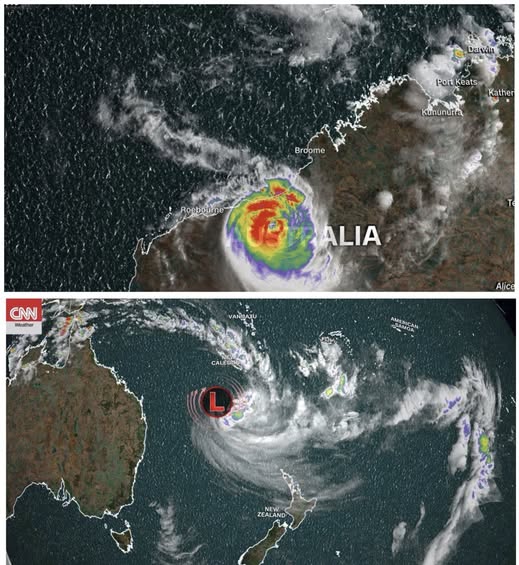Summary
Meteorologists from the U.S. National Hurricane Center (NHC) report that Hurricane Flossie has strengthened into a Category 3 major hurricane off Mexico’s western coast. This system, watched carefully over several days, now features sustained winds near 185 km/h (115 mph).
Though its center remains over open water, outer rainbands are already affecting parts of coastal Mexico—such as Michoacán, Colima, and Jalisco—bringing heavy rain and rough surf.
While Flossie currently shows no immediate threat of landfall, its proximity and slow forward motion may still trigger coastal flooding, swollen tides, and dangerous marine conditions.
Current Position & Forecast Movement
According to the latest NHC update, Flossie’s eye is located about 505 km (315 mi) south-southeast of Cabo San Lucas on the Baja California Peninsula. The storm is progressing toward the west-northwest at around 17 km/h (10 mph), a trajectory expected to persist over the next 24–36 hours.
Forecasts suggest that Flossie will hold its intensity through Wednesday, with a small chance of further strengthening. By week’s end, cooler sea surfaces and increasing wind shear are expected to erode its power, gradually weakening the storm as it moves farther out to sea.
Affected Regions
Although Flossie’s core is distant from land, its outer spiral bands are already brushing coastal states:
- Michoacán: intermittent heavy rain and gusty winds
- Colima: coastal swells and moderate precipitation in low‑lying zones
- Jalisco: increased cloudiness and intermittent intense showers
Local authorities have warned residents in vulnerable terrain to remain alert for flash flooding or landslides, particularly in areas already saturated by prior rainfall.
Government Alerts & Local Preparations
Mexico’s Civil Protection agency had earlier issued tropical storm warnings for coastal stretches between Punta San Telmo and Playa Pérula. However, as Flossie’s forecast track shifted west, those warnings were lifted.
Still, meteorologists emphasize the need for vigilance regarding rainfall impacts, especially flash floods or mudslides in rural and mountainous areas. Local officials have also advised tourists and boat operators to steer clear of open‑water activities until sea conditions stabilize.
How Hurricanes Form & Classification
In the eastern Pacific, hurricanes (or tropical cyclones) develop from clusters of thunderstorms over warm seas (typically > 26.5 °C or 80 °F). That heat energy fuels the storm, allowing winds to spiral inward and an eye to develop when intensity increases.
Why Scientists Are Watching Flossie
Flossie draws attention not just for its present strength, but for its broader behavior and implications:
- Its ability to maintain intensity far from land may reflect shifts in ocean temperature and atmospheric moisture.
- Storms like Flossie help scientists refine models, particularly for late‑season systems in the eastern Pacific.
- Observations contribute to understanding how climate variability influences hurricane formation and longevity.
In recent years, some hurricanes in this region have shown longer lifespans and farther reach than in the past, prompting interest in whether sea surface warming is playing a role.
Economic & Human Dimensions
Storms like Flossie can ripple through local economies: tourism, agriculture, and shipping may all see temporary disruption. Farmers may welcome moderate rains, but too much water in a short time can damage crops. Coastal towns with tourism dependency may adjust operations or recreational offerings in precaution.
Community resilience—including education about storms, building codes, and planning—determines how well towns cope before, during, and after weather events.
What’s Next for Flossie?
Models generally agree: Flossie will maintain a west-northwest trajectory, gradually weakening as it encounters cooler sea surface temperatures and increased wind shear. Late in the week, it may descend to Category 1 strength or even to tropical storm status.
Although direct landfall appears unlikely, coastal impacts—swells, rough surf, occasional rain showers—may linger along parts of Mexico’s coast through the weekend.
In Closing
Hurricane Flossie is a powerful reminder of how dynamic the Pacific basin can be—even when storms stay offshore. It highlights the value of robust forecasting, regional cooperation, and public awareness.
While the storm’s direct impact on land may remain limited, the lessons learned—from modeling techniques to emergency readiness—add to collective resilience. Each tropical system, whether benign or extreme, enriches our understanding of Earth’s complex climate systems.
As Flossie advances steadily out to sea, meteorologists will continue tracking its structure, refining predictions, and extracting data to strengthen future response. One message is clear: knowledge, respect for nature’s power, and preparedness remain key to weathering whatever comes n
